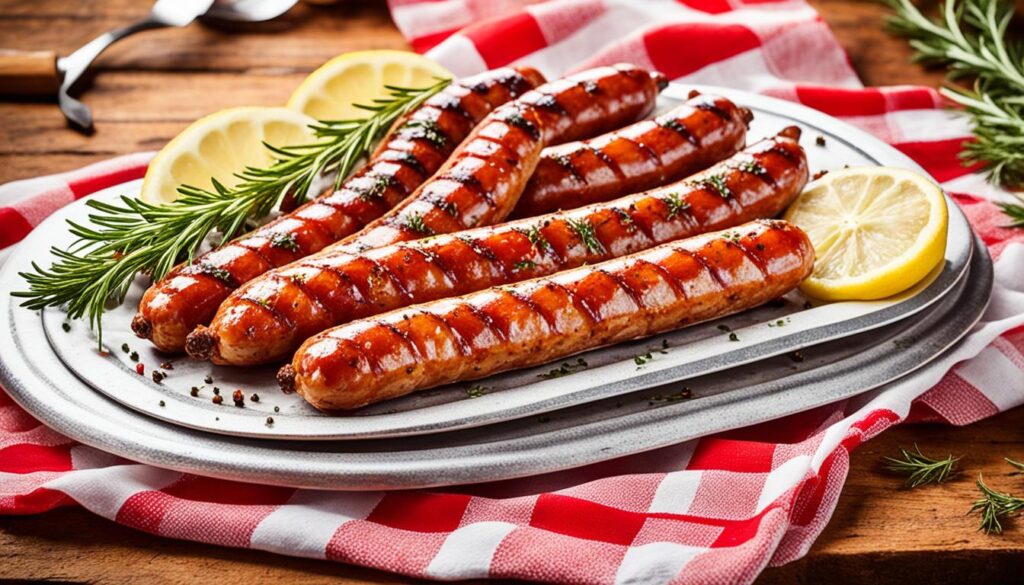Unlock the secrets of traditional Greek cuisine and savor the flavors of the Mediterranean with your very own homemade Greek loukaniko sausage. This cherished staple, known for its robust and aromatic character, has captured the hearts of food connoisseurs around the globe. As you embark on this culinary adventure, we’ll guide you through the rich history, essential ingredients, and expert techniques needed to craft the perfect loukaniko sausage. Whether a seasoned chef or a curious novice, you will find joy in making this Greek sausage recipe, one that honors tradition while embracing the unique flair of your personal kitchen.
If the thought of making your own loukaniko sausage seems daunting, fear not. Our step-by-step loukaniko recipe is designed to demystify the process, making it accessible for cooks at any skill level. By combining authentic Greek spices with high-quality meats, you’ll transform simple ingredients into a culinary masterpiece that’s bursting with flavor. So tie on your apron, preheat the grill, and get ready to discover how the humble loukaniko sausage can become the star of your dining table.
Key Takeaways
- Discover the rich historical background and cultural significance of Greek loukaniko sausage.
- Understand the importance of selecting the right ingredients to create an authentic Greek sausage recipe.
- Learn key techniques for blending, seasoning, and stuffing to achieve the perfect loukaniko sausage texture and taste.
- Gain insights on how to cook and serve loukaniko, ensuring each bite is a celebration of Greek culinary artistry.
- Enjoy the satisfaction of crafting a gourmet Greek sausage recipe from scratch, elevating your home cooking to new heights.
Exploring the Heritage of Loukaniko: A Greek Sausage Tradition
The deeply embedded loukaniko tradition in Greek culture encompasses far more than just a simple sausage; it represents a historical lineage of flavors and techniques preserved over centuries. As we delve into the history of loukaniko, we unveil layers of gastronomic storytelling that have passed through the ages, shaping the culinary identity of Greece. From the robust markets of ancient trade cities to the sizzling grills of modern-day tavernas, the Greek loukaniko is a testament to the endurance of tradition over time.
The Ancient Roots of Greek Loukaniko
The love affair with Greek sausages dates back to the times of Homer and Aristophanes, where loukaniko’s presence was lauded within the written and oral records. Loukaniko’s ancient roots are steeped in practices of preserving meats via flavoring and drying, methods which highlighted the ingenuity of early Greek gastronomes. The blend of herbs and spices used in traditional loukaniko recipes has seen subtle transformations, but the essence of the Greek sausage tradition endures in its savored aromas and flavors.
Loukaniko's Place in Spetsofai and Other Greek Dishes
Loukaniko, the quintessential Greek sausage, is known for its rich and distinctive flavors, which make it an integral component of various Greek dishes. Infused by an array of local herbs, the loukaniko elevates the palates of renowned dishes such as spetsofai—a rustic stew marrying the hearty textures of sausage with the crisp freshness of bell peppers and tomatoes. The versatility of the Greek loukaniko has allowed it to be seamlessly woven within the tapestry of Greek cuisine, finding its home among the myriad of traditional and contemporary dishes that epitomize Greece’s culinary heritage.
A visit to any Greek market will expose the plethora of loukaniko varieties available—each with their own story and specific blend of local fauna. As we continue to savor the rich tastes and textures of loukaniko, we also partake in a living history—one of culinary resilience, familial bonds, and an undying dedication to the cherishing of Greek sausage traditions.
Starting with the Basics: Ingredients and Equipment
Embarking on the journey of making authentic Greek sausage requires a selection of high-quality loukaniko ingredients, as well as the right sausage making equipment. For novices and seasoned sausage makers alike, having the essential sausage making supplies on hand is crucial to crafting delicious sheftalia sausages that highlight the rich flavors of Greek sausage ingredients.
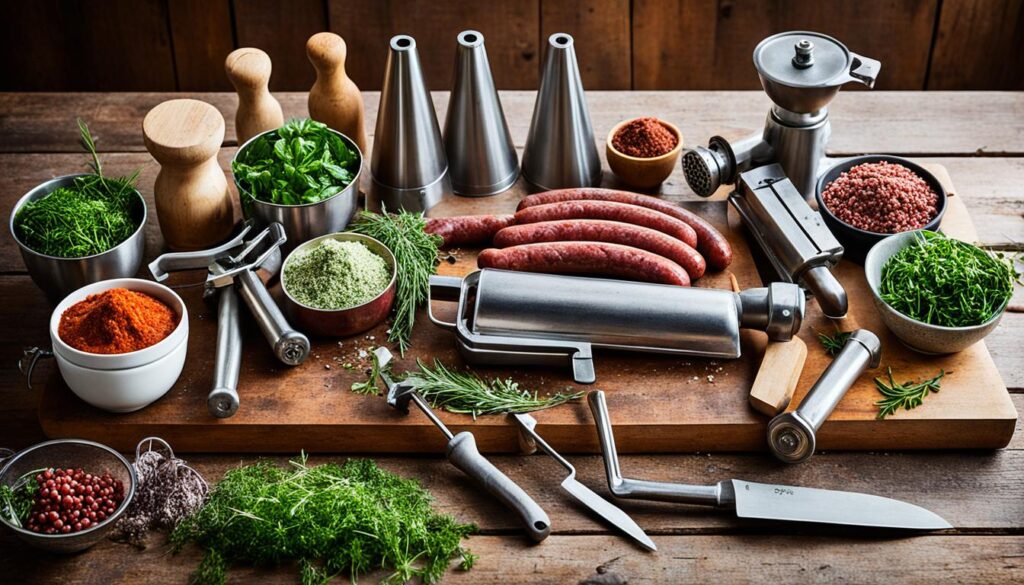
The cornerstone of great sausage making is the meat-to-fat ratio. For sheftalia sausage, aiming for a 30% fat content is optimal to achieve that succulent texture and flavor depth. When sourcing fatback and meat, remember that a good rule of thumb is one pound of fatback for every four pounds of meat. This ratio not only enhances taste but also ensures the appropriate texture for your sausages.
Moving to the grinding phase, a two-step grinding process is suggested to produce the best results. The first pass through the grinder breaks down the meat and fat into smaller pieces, while the second pass ensures an even consistency, vital for that characteristic loukaniko bite.
Once the sausages are filled and shaped, cooking them correctly is just as important as the preparation. It is recommended to cook the sausages until they reach an internal temperature of 160°F (71°C), as measured by an instant-read thermometer, to ensure they are both safe to eat and deliciously juicy.
| Sheftalia Sausage Recipe Data | Details |
|---|---|
| Meat-to-Fat Ratio | 30% Fat |
| Fatback to Meat | 1:4 Ratio (Fatback:Meat) |
| Grinding Process | Two-Step Grinding |
| Cooking Temperature | 160°F (71°C) |
| Servings | 6 to 8 |
| Preparation Time | 90 Minutes |
For those ready to dive into the world of sausage making, this basic rundown on ingredients and equipment will set a strong foundation for success. The art of creating sheftalia sausages, a beloved Greek tradition, is now within your grasp.
The Ideal Meat to Fat Ratio for Flavorful Loukaniko
When venturing into the world of homemade sausage crafting, particularly the Greek delicacy loukaniko, achieving the perfect meat to fat ratio is crucial. This balance is not just about flavor, but also ensures the right loukaniko texture and that each bite is a juicy loukaniko experience. Following time-honored traditions, the art of Loukaniko sausage-making involves a harmonious blend of meats, herbs, and meticulous processes.
Consider the traditional blend of three parts pork shoulder to one part leg of lamb, augmented by a pound of pork fatback; this specific combination defines a classic Loukaniko sausage. With a dedicated 30% fat content, it answers the universal quest for delectable, well-marbled sausages. To illustrate, a robust batch may include 3 pounds of pork shoulder, 1 pound of boneless leg of lamb, and the essential 1 pound of pork fatback. These proportions are not arbitrary, they have been fine-tuned over centuries to deliver the quintessential Mediterranean flavor profile.
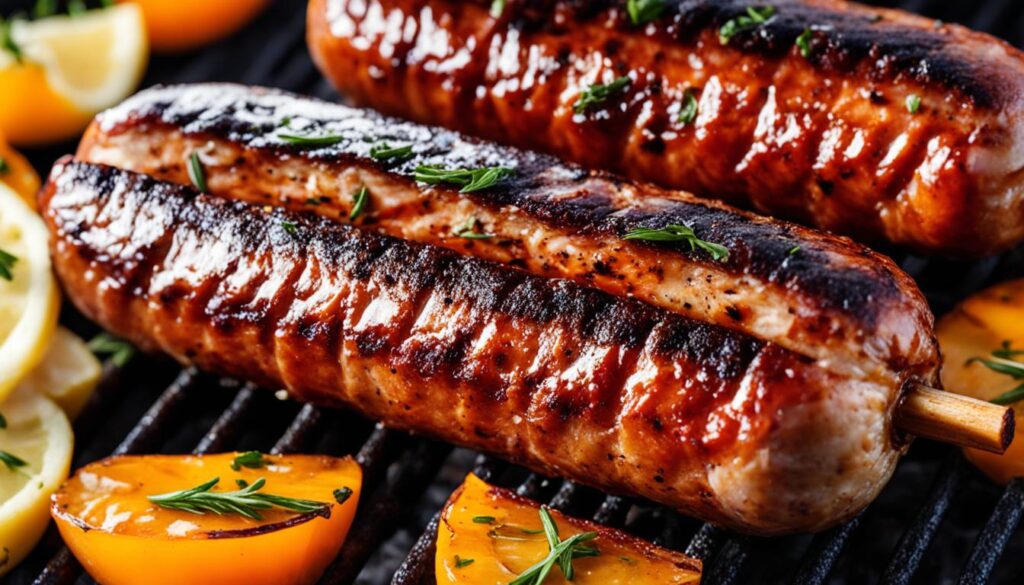
The eclectic mix of fresh ingredients lends itself to the uniqueness of Loukaniko. With each ingredient playing a pivotal role, a blend of 4 whole leeks, 9 medium cloves of garlic, 3 tablespoons of orange zest, and 1 tablespoon of coriander seeds imbue the sausage with an intoxicating savoriness. Achieving the ground meat ratio is just one part; these fresh components impart a soulful taste with their aromatic contributions.
Part of the Loukaniko-making journey includes curing and enhancing flavor development. A period of refrigeration, specifically uncovered for 2 to 3 days with daily rotations, is recommended for air-drying – a step that significantly influences the sausage’s loukaniko texture. Cold smoking the sausages at approximately 90°F for 1-2 hours will introduce a nuanced smoky undertone, while cooking them over high heat is advised to achieve a caramelized, crispy exterior that complements the juicy, flavorful interior.
For those preferring game meats, a variation with 70% ground venison and 30% pork fat lends a different dimension while maintaining the recommended meat to fat ratio for a juicy outcome. A final product of 7lbs of Loukaniko, structured around a 4lbs to 3lbs meat to pork fat ratio, stands as testament to the versatility of the recipe. It is imperative, however, to ensure that the rich amalgamation of spices and seasonings is uniformly distributed throughout the mixture to achieve the definitive Loukaniko symphony of flavors. The process, although labor-intensive, is a culinary ritual that grants a sense of accomplishment unparalleled by any store-bought alternatives.
Attention to detail extends to preparing hog casings, soaking them in tepid water, and flushing them with cold water prior to stuffing. This preliminary step coupled with expert sausage link forming, whether as long coils or specific 4-6 inch segments, adds finesse to your homemade Greek Loukaniko. A recognition of sausage-making complexities evokes the need for guidance from experienced masters such as Michael Rhulman, whose cookbooks serve as an invaluable resource to both novices and seasoned sausage artisans alike.
Mastering the Grinding Process: A Step-by-Step Guide
Perfecting the sausage grinding process is an art that requires precision and a bit of know-how. This comprehensive sausage grinding guide will walk you through each stage, ensuring that when you’re grinding sausages, the result is nothing short of perfection. Whether you’re a novice or a seasoned sausage maker, understanding the intricacies of the sausage grinder and the elements that contribute to a well-textured sausage is paramount.
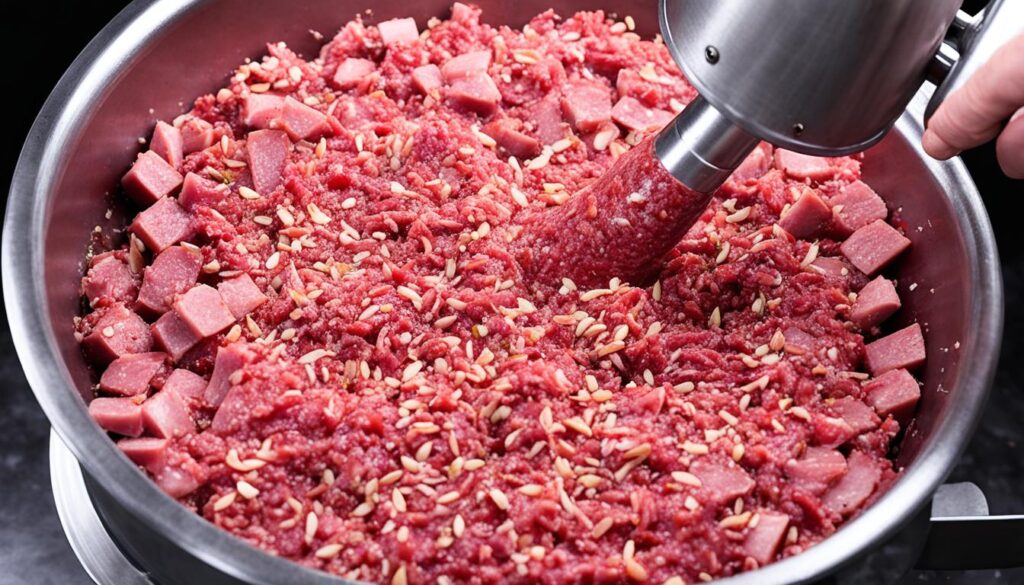
Before we delve into the waltz of the sausage grinder, let’s acknowledge the traditional loukaniko—a savory delight with a lineage dating back to Classical times. In crafting such ancient recipes, every detail matters, from the selection of meats—often a combination of pork and lamb—to the bouquet of spices, including garlic, citrus peel, and fennel, which are integral to loukaniko’s distinctive taste.
Selecting the Right Grinder for Your Sausage
To kick off the sausage grinding process, the quest for the ideal sausage grinder begins. Your choice of grinder can significantly impact the consistency and quality of your sausage. A robust grinder that can handle the rich blend of meats and accommodate the necessary fat content—which ranges from a lean 20% to a lush 35% in more emulsified varieties—is a pivotal investment. With such a device in your culinary arsenal, achieving that juicy, springy texture synonymous with premium sausage varieties becomes all the more attainable.
The Importance of Keeping Ingredients Cold
The cardinal rule of sausage crafting must not be overlooked: keep your ingredients, especially the meats and liquids, cold. Temperature plays a crucial role in meat texture and fat distribution. When the components, including the grinder parts, are adequately chilled—a practice that, statistically speaking, enhances the binding of the sausage—the risk of fat smearing is dramatically reduced, paving the way for a finer emulsion and more consistent grind.
Let’s not forget that the magic of loukaniko is partly fermented in patience. After seasoning, the pork should be left to rest and marinate for approximately eight hours, allowing the salt to work its wonders. Salt’s osmotic abilities transform proteins into a briny blend that aids in crafting that sought-after, bouncy texture. This process, alongside a critical resting phase post grinding, ensures a decrease in moisture loss for juicier, more robust sausages.
- It is essential to salt and cure the meat before the grind to enhance flavor and juiciness.
- For optimal texture, maintain all ingredients, including the meat and grinder components, at a cold temperature.
- Kneading the meat post grind can further perfect the consistency of your sausage.
Whether your loukaniko dances over an open flame or simmers in a stew, taking these steps in the sausage grinding process can elevate your creation from a mere meal to a masterpiece that echoes the culinary prowess practiced in pizzerias across the nation.
Infusing Loukaniko with Authentic Greek Seasonings
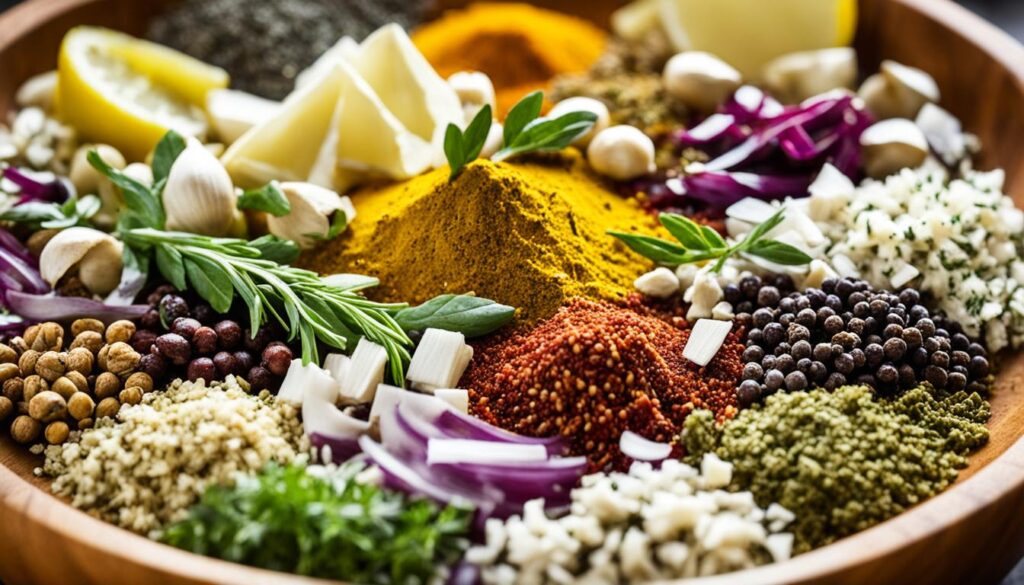
Embarking on the satisfying journey to create the perfect Greek loukaniko, it’s paramount to emphasize the traditional Greek flavors that emerge from the masterful blend of loukaniko spices. A carefully curated selection of Greek sausage seasonings not only imparts the unique taste profile loukaniko is famous for but also encapsulates the essence of Grecian culinary traditions.
The key to crafting an authentic loukaniko lies in the thoughtful combination of herbs and spices. Below is a curated list that serves as your guiding compass to getting those traditional Greek flavors right:
- Oregano – The quintessence of Greek seasoning, adding an earthy, slightly bitter taste that is unmistakable.
- Garlic – Emblematic for adding depth and warmth to any Greek dish, including loukaniko.
- Fennel Seeds – Imparting a licorice-like taste that’s a signature in many loukaniko recipes.
- Orange Peel – A unique addition that brings a citrusy zest, refreshing the palate.
- Smoked Paprika – Offers a gentle heat and smokiness, enhancing the sausage’s robust character.
These essential loukaniko seasoning blends are not just about flavor. When combined with high-quality meat and loving preparation, they are capable of transporting you to a seaside taverna with every bite. For a successful loukaniko, maintain a delicate balance among these Greek sausage seasonings to achieve harmony in your dish.
Immersion into the world of Greek sausage seasonings is more than a culinary practice; it’s a passage to the storied streets and rich history of Greek cuisine. Let these traditional spices and herbs become a staple in your kitchen, and watch as your homemade loukaniko becomes a beloved dish among friends and family, evoking a sense of nostalgia and delivering an authentic Mediterranean experience.
Advanced Techniques: Double Grinding for Texture
When it comes to crafting the iconic Greek loukaniko, achieving the perfect texture of loukaniko can significantly elevate the tasting experience. One of the advanced sausage grinding techniques utilized by seasoned sausage makers is double grinding sausages. This process not only refines the texture but also plays a pivotal role in creating techniques for juicier sausage. Let’s dive into how this method can transform your sausage-making endeavors.
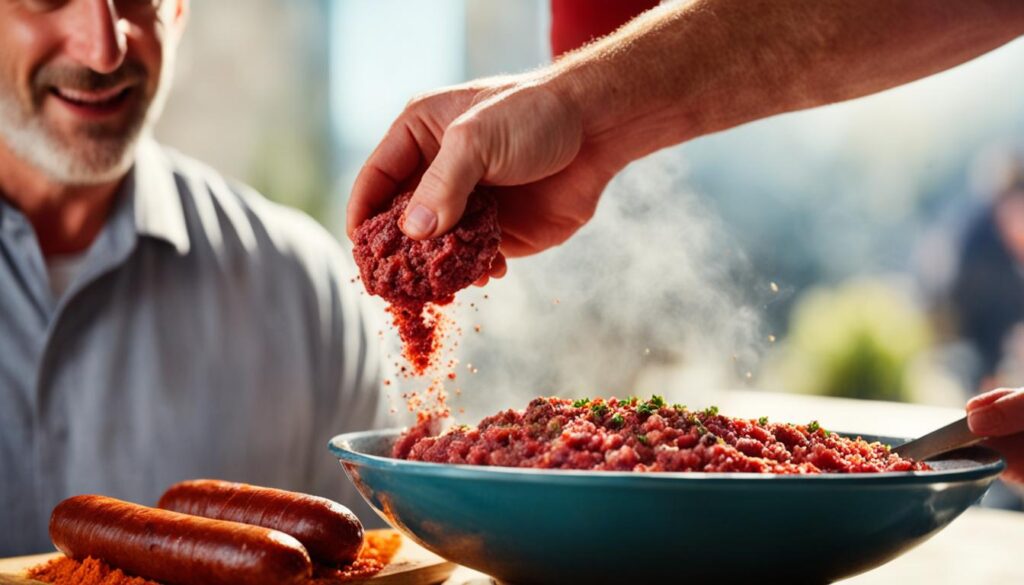
Double grinding involves passing your ground meat through the grinder twice. The first grind, typically with a larger die, breaks down the meat and fat into smaller pieces, whereas the second grind with a finer die, ensures a more homogeneous mixture and a finer consistency. This crucial step impacts the texture of loukaniko, resulting in a smoother yet firm bite that is highly sought after.
Here’s a simple guide to help you execute this method effectively:
- Start with a coarse grind using a larger plate (around 3/8-inch); this initial grind is about breaking down the meat into manageable pieces.
- Keep all your equipment and the meat mixture very cold between grinds to prevent fat smearing, which can impact the texture and cooking performance of the loukaniko.
- After the first grind, switch to a finer plate (1/8 to 3/16-inch) and perform the second grind. This finer grind enhances the sausage’s density, making for a better emulsion of fat and meat, which is key for a juicier sausage.
- During the second grind, make sure to feed the meat into the grinder at a consistent pace to ensure even texture throughout the batch.
Double grinding is not just about achieving a uniform texture; it also creates a better platform for spices and seasonings to be evenly distributed throughout the sausage, which is crucial for the complex flavor profile of loukaniko. With the right sausage grinding techniques, you can ensure your loukaniko has the ideal texture that is both delightful to the palate and traditional in style.
Whether you’re a home cook or a professional chef, incorporating double grinding sausages into your process can make a notable difference in the final product. This advanced technique, integral to producing a texture of loukaniko that stands out, is a testament to the careful craft that goes into making this beloved Greek sausage. With practice, patience, and precision, your efforts in double grinding will lead to a more succulent and juicier sausage, ready to be enjoyed in a myriad of Mediterranean dishes.
The Art of Stuffing Sausage: Traditional Methods and Modern Tips
Creating mouthwatering loukaniko begins with mastering the art of sausage stuffing, a skill that combines tradition with modern practices. Proper sausage stuffing techniques are crucial to avoid the frustration of casing blowouts and ensure a beautifully crafted final product. With an eye on detail, let’s delve into the preparations for those all-important loukaniko casings and understand how to manage airflow during the stuffing process.
Preparing Casings for the Perfect Loukaniko
Successful sausage casing preparation starts with choosing quality loukaniko casings and handling them with care. Soak the casings in room temperature water to rinse away any salt and to make them more pliable. Then, run lukewarm water through the inside of each casing to check for leaks, which can lead to blowouts during the stuffing phase. It’s this respectful nod to the traditions that paved the way for companies like Leon’s Sausage Co., which began from a humble home kitchen and grown exponentially in size, likely due in part to meticulous sausage craftsmanship.
The Role of Airflow: Avoiding Tears and Blowouts
Even airflow is paramount when stuffing sausages to prevent undue pressure from tearing the casings. The aim is to fill the casings fully but not too tightly, allowing some room for the mixture to move without causing strain. Preventing blowouts is not just about the technique; it also involves paying attention to the casing quality and ensuring a seamless filling experience. This attention to airflow helps replicate the quality of sausages found at Schmeisser’s Home Made Sausages on Milwaukee Avenue, where tradition meets modern palate preferences.
The technique and tips provided reflect a commitment to tradition while embracing modern improvements, just like the evolution seen in Chicago’s and California’s ever-expanding sausage markets. From specialty brands to international varieties like Greek sausage loukaniko or Chicken Basil With Sun-dried Tomato featured at Whole Foods Market, the process of stuffing sausages transcends boundaries and continues to be a celebrated culinary art form.
| Year | Event or Milestone | Significance |
|---|---|---|
| 1925 | Chicago lists 87 sausage manufacturers | Reflection of the city’s rich sausage-making heritage |
| 1925-1929 | Leon Tiahnybik starts Leon’s Sausage Co. | Embodiment of American dream and growth in the industry |
| 1990 | Publication of “Hot Links and Country Flavors” | Highlight of the Californian sausage revolution |
| Historical Period | Consumption by Babylonians, Greeks, and Romans | Culinary tradition dates back to 1500 B.C. |
Embracing the craftsmanship of sausage making is not just about the preparation; it’s a homage to a tradition that has made dinner tables rich with cultural heritage and gastronomic delight. Whether it’s the old Romans combining nuts and bay leaves or modern American twists with apple sausage and tofu, sausage remains a symbol of ingenuity and cultural expression.
The Perfect Greek Loukaniko Sausage: Linking and Twisting Secrets
Achieving the quintessential loukaniko presentation begins with mastering the age-old sausage linking techniques. The craft of loukaniko twisting not only contributes to the sausage’s aesthetic appeal but also ensures even cooking and consistent flavor throughout. This artful process, if done correctly, culminates in beautifully coiled sausages that are synonymous with traditional Greek fare. We’re about to uncover the revered methods that lead to perfectly linked and coiled Greek loukaniko sausages.
Creating Uniform Links for Consistency
For a sausage to cook evenly, it must have uniformity in size and shape, and this is where sausage linking techniques play an indispensable role. Consistent links are achieved by measuring equal lengths of sausage before twisting. It’s a rhythm that, once mastered, results in a series or chain of sausages that are equally plump and ready for the grill or pan.
Coiling Techniques for Authentic Loukaniko Presentation
To present loukaniko in its most authentic form, coiling sausages becomes an important step. Typically, after linking, the sausage strand is coiled into a spiral, which allows for easy storage and an impressive display when served. Coiling is not only practical but also nods to the tradition and care put into homemade Greek cuisine.
Below we’ll glance over some intriguing sausage industry data that ties in with the importance of coiling and presentation in loukaniko and other types of sausage making.
| Brand or Producer | Variety of Sausages Offered | Signature Sausage | Awards/Recognition |
|---|---|---|---|
| Yanni’s Sausage Grill | 8 | Loukaniko | Best of Show Charcuterie, Sonoma County Harvest Fair (2 Years) |
| Angelo’s Meats | 18 (12 Smoked) | Hawaiian Portuguese | – |
| Richard Caggiano | 23 | Hot Smoked Beer Sausage | – |
| Franco’s One World Sausage | 65 | Cottechino (Winter) | – |
| Diavola (Dino Bugica) | Specialized Italian & Middle Eastern | Moroccan Chicken Thigh with Apricots, Almonds, Harissa | – |
Not only is the production of these links a testament to the meticulous craft of sausage making, but also a shining example of how sausage linking techniques can complement a brand’s signature style. The precise methods employed in both linking and coiling not only preserve the essence of loukaniko but also serve as a canvas for presenting a culinary tradition that has been passed down through generations.
Safe Sausage Making: Health Precautions and Best Practices
In the world of homemade sausage delights, such as the Greek Loukaniko, sausage making safety cannot be overemphasized. With this delicious sausage specialty gaining popularity across the Mediterranean and beyond, understanding and implementing proper food safety practices is key to both the enjoyment and health of sausage connoisseurs. Crafting the perfect Greek Loukaniko sausage recipe involves more than just a mastery of ingredients and techniques—it’s also about ensuring the safety and healthfulness of the food we make and consume.
Understanding the Risks and How to Mitigate Them
The risks associated with improper sausage making are varied, ranging from bacterial contamination to spoilage. However, knowing how to manage these risks can lead to the safe production of high-quality sausages. By adhering to strict hygiene standards and utilizing proper sanitation methods, the risks can be substantially minimized. In addition, being well-informed about homemade sausage precautions plays a crucial role in this process.
Sanitation and Storage Tips for Homemade Sausage
Once your sausages are prepared, proper sausage storage becomes paramount to maintaining freshness and preventing potential foodborne illnesses. Safeguarding the quality and extending the shelf life of your homemade sausages involves not only proper refrigeration or freezing but also ensuring that they are stored in conditions that prevent cross-contamination.
Below are essential tips and best practices to ensure the top-notch quality and safety of your sausage making endeavor:
- Maintain a clean and sanitized workspace and equipment.
- Wash hands thoroughly before and during the sausage making process.
- Keep all ingredients, especially meat, properly refrigerated until use.
- Cook sausages to recommended temperatures to ensure all bacteria are killed.
- Store finished sausages in airtight containers to prevent air exposure and contamination.
Abiding by these guidelines will help maintain the integrity of your homemade sausages and provide peace of mind when it comes to the safety of your culinary creations.
| Precaution | Description | Benefit |
|---|---|---|
| Hygiene Maintenance | Regularly clean surfaces and tools with appropriate sanitizers. | Reduces the risk of bacterial cross-contamination. |
| Temperature Control | Use thermometers to ensure meat is stored and cooked at safe temperatures. | Prevents growth of harmful bacteria that can cause illness. |
| Airtight Storage | Use sealed containers or vacuum packing for storing sausages. | Extends shelf life and retains freshness. |
In conclusion, adhering to sausage making safety and food safety practices is non-negotiable when crafting sausages at home, especially when dealing with specialty recipes like the Greek Loukaniko. It’s not just about flavor and tradition; it’s about delivering a product that’s as safe as it is delectable. Embrace these safety measures, and let the legacy of Mediterranean Mastery continue with confidence in every bite.
Greek Loukaniko Sausage: Serving Suggestions and Pairings
When the delightful aroma of Greek Loukaniko sausage fills the kitchen, the perfect dish calls for equally sublime sides and pairings. Whether nestled within a rich, satisfying casserole or served as a standalone centerpiece, these loukaniko serving suggestions will transform any meal into a Mediterranean feast. From a simple array of dips to a more intricately prepared side, each addition is chosen to complement the robust flavors of Greek sausage dishes.
Traditional Greek Sides to Complement Loukaniko
Inspired by a medley of traditional culinary practices, the most recommended sides include a variety of nine distinct dishes. Amongst these, a fresh and vibrant Greek Salad is suggested 11% of the time, introducing a refreshing crunch to balance the richness of loukaniko. Not to be overlooked, the classic Tzatziki & Breadsticks pairing also makes up 11% of recommendations, offering a creamy and tangy counterpoint with an added textural contrast.
- Potato variations stand out as a favorite for one-third of these side dishes, offering a hearty and rustic complement to the sausage.
- Vegetable-based side dishes, with choices spanning from oven-roasted peppers to seasoned artichokes, account for 4 out of the 9 recommended sides.
- For those who favor a touch of indulgence, a duo of dairy or cheese included sides such as feta-sprinkled roasted zucchini confirms Greek sausage pairings can be both flavorful and nutritious.
Inspired Recipes Incorporating Greek Sausage Loukaniko
When it comes to loukaniko recipes, there is a wealth of options. Olympia Provisions’ acclaimed Rigani Loukaniko, composed of local, antibiotic-free pork and a symphony of Greek-inspired herbs and orange zest, serves as the exquisite foundation for a myriad of dishes. While there are no specific protein accompaniments outlined, the loukaniko stands robustly on its own, inviting chefs to experiment within their culinary palates.
| Dish Type | Percent Recommended | Nutritional Content (Per Serving) |
|---|---|---|
| Salad | 11% | Calories: 437kcal, Sugar: 5.1g, Fiber: 2.6g |
| Dips & Bread | 11% | Fat: 35.4g, Sodium: 1069mg |
| Potatoes | 33% | Carbohydrates: 10.5g, Protein: 12.2g |
| Vegetables | 44% | Cholesterol: 57.8mg, Saturated Fat: 10.2g |
| Cheese & Dairy | 22% | Unsaturated Fat: 23.3g, Trans Fat: 0g |
Whether opting for a salami that is a perfect testament to the age-old tradition of Greek sausage — elegantly crafted with care and authentic spices — or integrating the sausage into inventive Greek sausage dishes, the culinary journey promises an unforgettable foray into Hellenic flavors. With the useful statistics on side dishes and a nod to the versatility of loukaniko, each meal transition becomes a delightful exploration of taste and texture, paying homage to the rich gastronomic legacy of Greece.
Conclusion
As our journey through the savors and skills behind crafting the perfect Greek Loukaniko sausage concludes, we take a moment for some final thoughts. The art of sausage making is steeped in tradition and nuance, speaking to the innovation and passion that has spanned generations and geographies. By exploring the history of flavorsome links from the ancient routes of Proto-Germanic languages to the sun-drenched hills of Greece where Φρεσκως epitomizes the zest of authentic ingredients, we see just how much the narrative of “fresh” has colored our gastronomic lexicon and practices.
The summary of loukaniko recipe steps provided demystifies the process, empowering aspiring chefs and home cooks alike to undertake the rewarding task of creating their own Mediterranean delicacies. Revealing the nuances of meat selection, grinding techniques, seasoning balances, and safe preparation practices, this guide aims not only to inform but also to inspire kitchen artisans to embrace the craft of sausage making.
As concluding thoughts, the pleasures of gastronomy are echoed in the symphony of tastes and textures that Greek Loukaniko offers. Whether served within the comforting walls of Xanthi Greek Food or plated in your own home, the sausage commands a presence, a legacy of flavors that are as timeless as they are bold. So, we leave you with the invitation to take these recipes, these scraps of history and culture, to your kitchens and tables—continuing the tradition that makes the Greek Loukaniko an enduring staple in a world brimming with culinary wonders.

